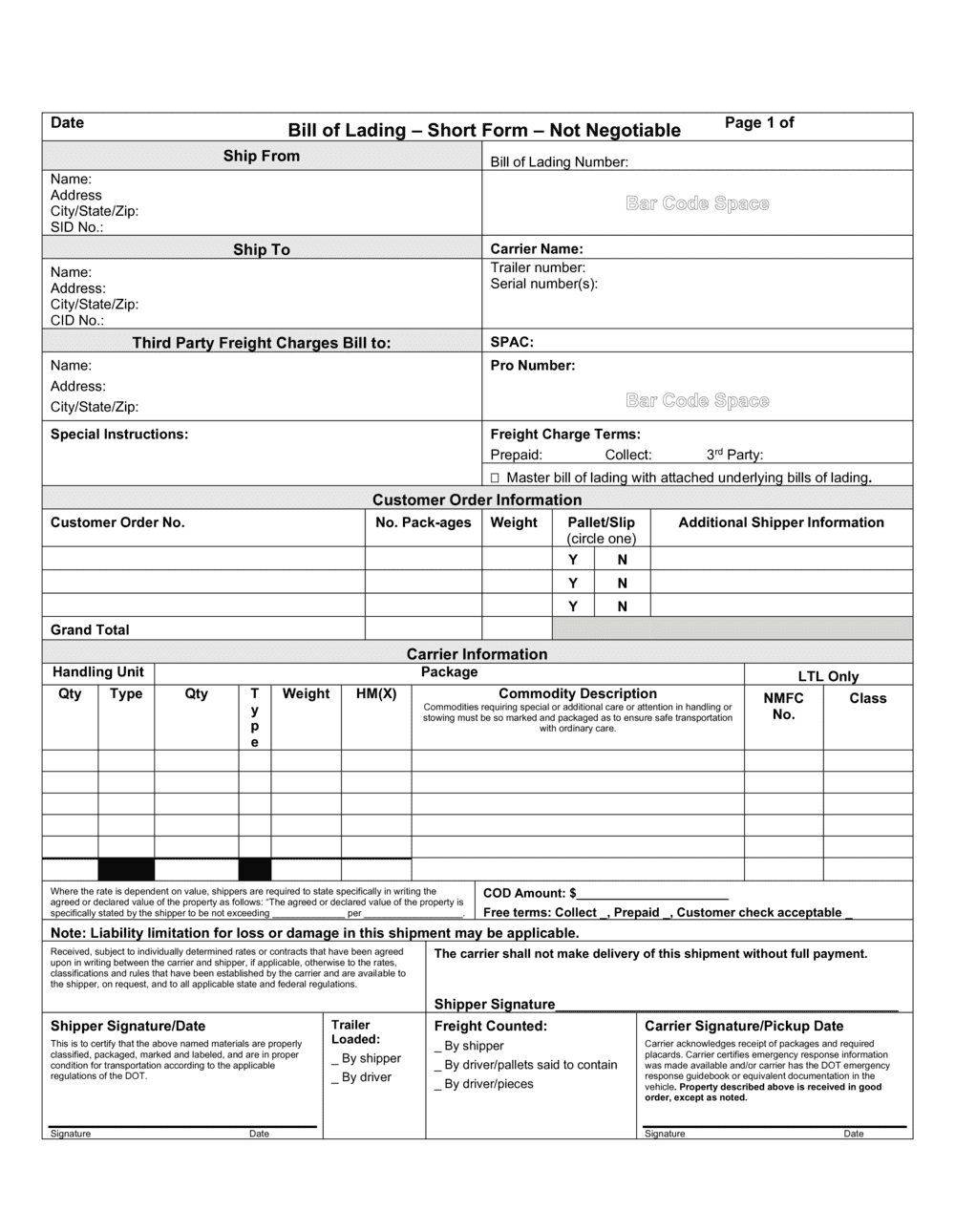Bill of Lading Template

Understanding a Bill of Lading
A Bill of Lading (BOL) is a critical document in the logistics and shipping industry. It serves as a contract and receipt for transported goods. It defines the terms and conditions of the shipment and provides detailed information about the goods being transported, the involved parties, and the transportation process. It ensures transparency, accuracy, and accountability in shipping.
What is a Bill of Lading Template?
A Bill of Lading template is a structured guide that helps parties accurately document and manage the transportation of goods:
- Shipper and Consignee Information - Provides the names and contact details of the shipper and the recipient of the goods.
- Carrier Details - Includes the name and contact information of the carrier responsible for transporting the goods.
- Shipment Description - A detailed description of the goods being transported, including weight, dimensions, and quantity.
- Packaging and Handling Instructions - Specific instructions for how the goods should be packaged, loaded, and handled to ensure safe delivery.
- Freight Charges and Payment Terms - Details the costs associated with shipping and the terms for payment.
- Delivery Terms - Outlines the terms and conditions for the delivery, including timeframes and locations.
- Signature and Date - The shipper and carrier's signatures, along with the shipment date, to validate the document.
Supporting Documents for Structuring a Bill of Lading
To enhance the clarity and comprehensiveness of a Bill of Lading, integrating related documents is advisable:
- Commercial Invoice - A detailed statement of the goods being shipped, including pricing, to support customs clearance and taxation.
- Packing List - An itemized list of all items included in the shipment, aiding in verification upon delivery.
- Export Control and Trade Compliance Policy - A policy that outlines guidelines to ensure lawful export of goods and services, maintaining compliance with international trade regulations and safeguarding against violations.
Why Use a Comprehensive Bill of Lading Template?
Using a structured template for drafting a Bill of Lading offers significant benefits:
- Accuracy and Consistency - Ensures accurate recording of shipment details, reducing the likelihood of errors.
- Legal Compliance - Aligns with international shipping regulations, minimizing legal risks.
- Accountability - Clearly defines the responsibilities of the shipper and carrier, providing a basis for resolving disputes.
- Streamlined Logistics - Facilitates efficient management of goods in transit, supporting smooth logistics operations.
Adopting a comprehensive Bill of Lading is crucial for ensuring the smooth transportation of goods. It provides a clear and actionable framework for shipment terms, supporting transparency and accountability in logistics.
Updated in May 2024.
Reviewed on

Understanding a Bill of Lading
A Bill of Lading (BOL) is a critical document in the logistics and shipping industry. It serves as a contract and receipt for transported goods. It defines the terms and conditions of the shipment and provides detailed information about the goods being transported, the involved parties, and the transportation process. It ensures transparency, accuracy, and accountability in shipping.
What is a Bill of Lading Template?
A Bill of Lading template is a structured guide that helps parties accurately document and manage the transportation of goods:
- Shipper and Consignee Information - Provides the names and contact details of the shipper and the recipient of the goods.
- Carrier Details - Includes the name and contact information of the carrier responsible for transporting the goods.
- Shipment Description - A detailed description of the goods being transported, including weight, dimensions, and quantity.
- Packaging and Handling Instructions - Specific instructions for how the goods should be packaged, loaded, and handled to ensure safe delivery.
- Freight Charges and Payment Terms - Details the costs associated with shipping and the terms for payment.
- Delivery Terms - Outlines the terms and conditions for the delivery, including timeframes and locations.
- Signature and Date - The shipper and carrier's signatures, along with the shipment date, to validate the document.
Supporting Documents for Structuring a Bill of Lading
To enhance the clarity and comprehensiveness of a Bill of Lading, integrating related documents is advisable:
- Commercial Invoice - A detailed statement of the goods being shipped, including pricing, to support customs clearance and taxation.
- Packing List - An itemized list of all items included in the shipment, aiding in verification upon delivery.
- Export Control and Trade Compliance Policy - A policy that outlines guidelines to ensure lawful export of goods and services, maintaining compliance with international trade regulations and safeguarding against violations.
Why Use a Comprehensive Bill of Lading Template?
Using a structured template for drafting a Bill of Lading offers significant benefits:
- Accuracy and Consistency - Ensures accurate recording of shipment details, reducing the likelihood of errors.
- Legal Compliance - Aligns with international shipping regulations, minimizing legal risks.
- Accountability - Clearly defines the responsibilities of the shipper and carrier, providing a basis for resolving disputes.
- Streamlined Logistics - Facilitates efficient management of goods in transit, supporting smooth logistics operations.
Adopting a comprehensive Bill of Lading is crucial for ensuring the smooth transportation of goods. It provides a clear and actionable framework for shipment terms, supporting transparency and accountability in logistics.
Updated in May 2024.
Easily Create Any Business Document You Need in Minutes.

Download or open template
Access over 3,000+ business and legal templates for any business task, project or initiative.

Edit and fill in the blanks
Customize your ready-made business document template and save it in the cloud.

Save, Share, Export, or Sign
Share your files and folders with your team. Create a space of seamless collaboration.


